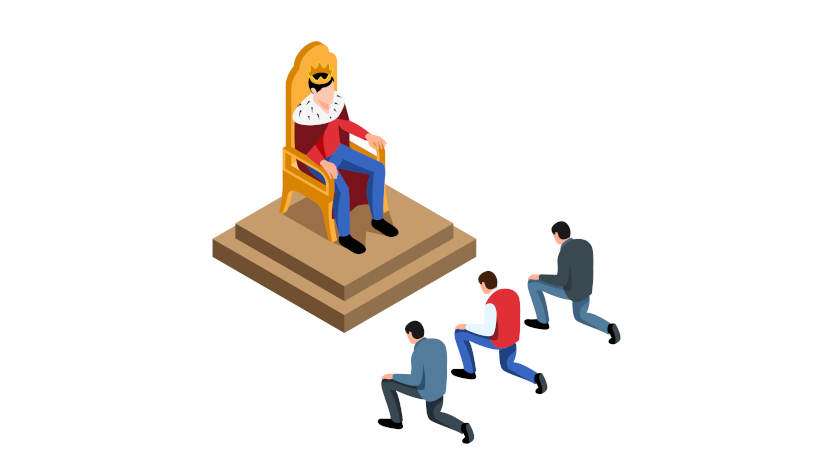Leading a team successfully is anything but easy. However, as a leader, that’s exactly your job. Quite a lot of responsibility, right? There are many different ways to lead, but each leader must find their own leadership style. This depends on their personality, the company, as well as the team. We will introduce you to the most common leadership styles and take a look at what leadership could look like in the future.
The leadership style defines a leader. Of course, it always depends on the individual and the company. Leadership styles are extremely important components of personnel management.
The individual leadership styles, which are explained below, are model-oriented and rarely occur in their written down form. As mentioned earlier, the reason for this is mostly situational context. Qualifications, experience, and personal demands influence the leadership style, resulting in mixed forms of leadership styles being common.
Leadership styles according to Max Weber
About 100 years ago, sociologist Max Weber asked himself this question, “Why do people allow themselves to be controlled?” Based on what he found out, the following leadership styles emerged:
Autocratic leadership style
With the autocratic leadership style in place, the boss makes important decisions in the company almost completely by himself. Additionally, this leader has a lot of influence on the work of employees. As a result, they have little potential to express themselves and contribute with their own ideas.
This leadership style can be effective when quick decisions and clear instructions are necessary. However, it can also lead to employees feeling unappreciated and demotivated.
Important characteristics:
- Employee monitoring
- No employee inclusion for decision-making
- Authoritarian leadership
Patriarchal leadership style
When this leadership style applies, the influence of the leader remains is similar to the autocratic leadership style. However, here subordinates have a certain level of trust in the “patriarch or matriarch”. This is why this type of leadership is also referred to as a paternal leadership style. The leader genuinely cares about the well-being of their employees. Their position is defined in part by their experience and age. However, this leadership style is not found in many companies nowadays.
Important characteristics:
- Conservative leadership
- Focus on hierarchy
- Clear power structure
Charismatic leadership style
Charismatic leaders are characterized by a strong personality and persuasive presence. They have a clear vision and can inspire and motivate employees to share and pursue that vision. Their persuasiveness and strong personality are among their most important qualities in fostering a positive attitude and high motivation among their employees. However, a charismatic leadership style can also lead to employees becoming too dependent on the leader and suppressing their own ideas and opinions.
Important characteristics:
- Leader as motivator and inspiration
- Empathy
- Solidarity
Bureaucratic leadership style
The bureaucratic leadership style is characterized by a strong emphasis on rules and hierarchies. Employees are expected to follow them closely. There is little room for flexibility or creativity, as everything must run according to a predetermined plan and strict guidelines. Decisions are made based on objective factors and formalities, and there is little room for personal relationships or emotions. Although this leadership style can provide a well-organized and stable work environment, employees may feel patronized, unmotivated, and unproductive.
Important characteristics:
- Slow decision-making process
- Bureaucracy and administration
- Strict hierarchies
Leadership styles according to Kurt Lewin
Another important representative when it comes to leadership styles is the psychologist Kurt Lewin. He identified three basic leadership styles: the authoritarian, the democratic, and the laissez-faire leadership style. It is important to note that there is no “right” or “wrong” leadership style, but rather the most suitable one depends on the situation.
Authoritarian leadership style
Lewin’s authoritarian leadership style is similar to Weber’s autocratic leadership style. It is characterized by a clear hierarchy and centralized decision-making. The leader gives clear instructions without involving their employees in the decision-making process. Employees are encouraged to follow these instructions exactly, and there is little room for discussion or creativity.
Democratic leadership style
This leadership style is also referred to as cooperative leadership style. The leader involves employees in various decisions, open discussions and joint decision-making are important aspects. This leadership behavior has a positive impact on employees – performance, motivation, work ethic, and the willingness to contribute new ideas, are promoted. The leader also sees a great advantage in the involvement of employees, namely due to the workload relief.
Laissez-faire leadership style
This leadership style is characterized by the autonomous work of the employees. Tasks and organizational structure are chosen by themselves. The superior does not intervene.
Through this leadership style, employees learn to work independently and make their own decisions. Possible disadvantage: it could lead to chaos or group disputes.
Modern leadership
Leadership is by no means static and constantly evolves. With the changing nature of work due to modernization, increasing economic challenges on a global level, and the growing individualization of employees, hierarchies must give way to new participatory systems. We will present you with three examples of modern leadership that are currently gaining significant importance.
1.Distributed leadership
Goodbye boss: The “big boss” will soon be history. With distributed or “shared” leadership, the leadership role is carried by several people. This does not mean that the leadership level simply multiplies by distributing tasks among bosses: rather, team members are actively involved in decision-making processes, take responsibility for their areas, and are supported and challenged. Simple completion of to-do lists no longer exists – colleagues must think along and work independently. This not only strengthens the team spirit, but also increases the motivation of the group, which leads to higher efficiency.
For the former boss, this change can be difficult at first – after all, he or she must now build trust that processes can function without his or her iron hand. He or she steps back from a controlling role to a coordinating role.
2. Inspirational leadership
The inspirational leader goes one step further. Here, the boss becomes a coach. The team is motivated by a shared sense of purpose to find their own ways and to work for the company. Simon Sinek introduced this idea to the public about 10 years ago and is still celebrated for it: he recommends starting out with the “why”. A person who doesn’t know why they are doing something will quickly lose focus, joy, and motivation (see also “incentives for employees“). For the inspirational leader, team work always revolves around one question: Why do we do what we do? What is the reason, the vision, our contribution to the world that we achieve with our work? Why do we want to achieve this together? Based on this, the employees are inspired to go beyond their limits.
3. Artificial intelligence and leadership
The employees of the future are called AI (Artificial Intelligence). On the one hand that’s sad, on the other hand quite cool. One thing is for sure: we have to adapt and prepare for this change. Teams are increasingly working together with robots and intelligent machines, and leaders are now only leading partially human teams. This is particularly challenging for the employees who have many fears that a strong leader must compensate for. The shared role here is especially challenging: human employees require charisma from their leader. Machines, on the other hand, require increased attention, especially in ethical and moral aspects. Because, yes: even a robot should be able to feel like part of the team.
See also: Beginners Guide to Remote Management
Situational leadership
Have you ever heard about situational leadership? The theory behind the principle supports the idea that the leadership style should depend on what your team actually needs in specific situations. Read more and try out our free test to identify your leadership style!
So which leadership style is the best?
So, which leadership style is the best? A question that is difficult to answer. Each style comes with important advantages and disadvantages that depend on the specific situation. Many factors are involved, which results in a situational leadership style – depending on the situation, the ideal leadership style proves to be effective.
VIDEO: Simon Sinek on why good leaders make you feel save
Leadership styles FAQs
What leadership styles are there?
Depending on the source, leadership styles are categorized differently. A popular model divides into four styles: Autocratic, patriarchal, charismatic and bureaucratic.
What leadership styles are most effective?
While a democratic leadership style has proven to be effective and employee friendly, there is no such thing as ONE perfect leadership approach. A good leader is able to switch between different styles depending on the situation.
Can leadership styles change?
While some leaders might have tendencies to become more autocratic over time, others found it to be highly effective to adapt the leadership style according to the given situation. So leadership styles can change, both, for better and worse.
Are leadership styles and theories the same?
While Leadership Theory focuses on why certain leaders are successful, Leadership Styles are characterizations of the traits and behaviors of leaders that distinguish one style from the other.




